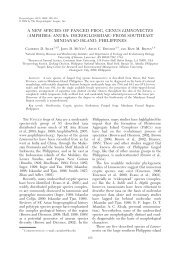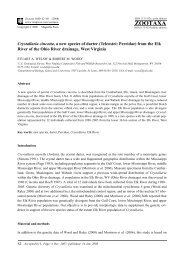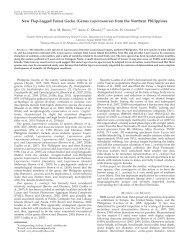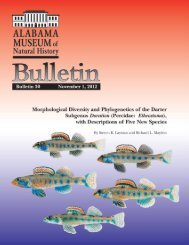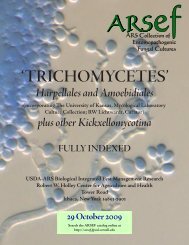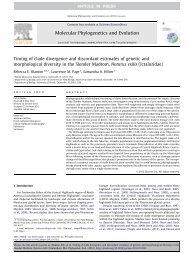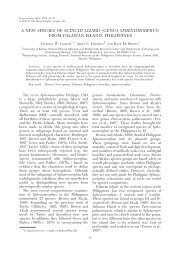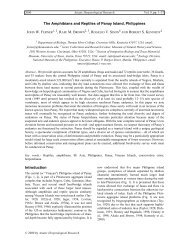by Rafe M. Brown, Renato Boying Fernandez, Chrisostomo Rivero ...
by Rafe M. Brown, Renato Boying Fernandez, Chrisostomo Rivero ...
by Rafe M. Brown, Renato Boying Fernandez, Chrisostomo Rivero ...
- No tags were found...
Create successful ePaper yourself
Turn your PDF publications into a flip-book with our unique Google optimized e-Paper software.
Recent biological survey efforts have demonstrated thehighly unique nature of the mountain’s mammal and birdfaunas, and the few available published reports suggestthat the same may be true for Mt. Isarog’s amphibiansand reptiles. At the start of our study, we hoped toascertain to what degree the amphibian and reptilefaunas of Mt. Isarog are also locally unique, to identifyspecies of special concern for conservation efforts, tolearn from local communities about the diversity, uses,and beliefs surrounding Mt. Isarog’s herpetofauna, andto contribute to local environmental education, pride,and increased awareness of the mountain’s amphibianand reptile communities.During July and August 2001, with the cooperationand guidance of the Parks and Wildlife Bureau of theDepartment of the Environment and Natural Resources(PAWB-DENR) and the Naga City Provincial Environmentand Natural Resources Office (PENRO), biologistsfrom the Haribon Foundation, the University of Texas,and the Mt. Isarog National Park Protected Area ManagementBoard joined collaborators for a preliminarysurvey of the herpetological fauna of Mt. Isarog’shigher montane forests. Here we present a firstglimpse at the unique and spectacular diversity of Mt.Isarog’s lizards, frogs, and snakes. Future expeditionswill extend our elevational transects to higher sites inmossy forests and will circumnavigate the mountain inan effort to survey drainages other than the one thatencompassed our base in Barangay Panicuason,Municipality of Naga City on the western slopes ofMt. Isarog.For our initial study, we utilized the same transectsand field sites that were studied during earlier investigationsof the mountain’s birds and mammals. One ofthe goals of the earlier studies was to conduct baseline faunal studies of species’ abundance and distributionalong elevational transects within Mt. IsarogNational Park. Wishing to contribute in a meaningfulway to this body of knowledge, we structured ourinitial study in a manner that was complimentary toabove: Maps of estimated forest cover on southernLuzon and adjacent islands in 1880, 1905, 1963and 1987, showing the loss of old-growth forest.below: Map of Mt. Isarog showing the boundariesof the National Park.opposite page: A misty forest scene in the lateafternoon, following heavy rain at 1150 m.Isarog’s earlier mammal and bird surveys to allow directcomparison to the results of these seminal studies. Futuretechnical and popular publications will accentuate thesecomparisons and determine to what degree patterns ofspecies richness and abundance along elevational gradientsdiffer from those described in birds and mammals.Arriving at the Mt. Isarog National Park headquartersin Barangay Panicuason, we were immediately joined <strong>by</strong>HARING IBON October November December 2001 13
Mt. Isarog forest frogsleft from top to bottom:the Isarog Cloud Frog (Platymantis isarog –male guarding eggs); the two-spotted tree frog(Rhacophorus bimaculatus); and the Luzonstream frog (Rana luzonensis)below: a “new,” unnamed species of forestfloor litter frog, genus Platymantis14 HARING IBON July October August November September December 2001 2001
Mt. Isarog forest lizardsclockwise from top: bark skink (Lipinia pulchella),bent-toed forest gecko (Cyrtodactylus cf annulatus),litter skink (Sphenomorphus decipiens), agamidangle-head lizards (Gonocephalus sp., andBronchocela cristatella), and crocodile skink(Tropidophoris grayi)HARING IBON October November December 2001 15
Mt.Isarogforestsnakesclockwise from left: the ratsnake (Elaphe erythrura),the Philippine pit viper(Trimereserus flavomaculatus),a possible newspecies of burrowing snake(Oxyrhabdion cf leporinum),and a still-unidentified blindsnake (Typhlops sp.)16 HARING IBON July October August November September December 2001 2001
local mountain enthusiasts and parkauthorities and guided to a base campat 450 meters above sea level. Fromthere, we later extended survey effortsto 950, 1150, and finally 1350meters. At these higher evelations,rainy season precipitation is usuallyheavy in the afternoons and evenings,rendering the forest beautiful, radiantand green, with a freshly-scrubbedappearance that is renewed withevery rainfall. It is on these nights,following heavy rains, that weexperienced some of the most impressivenocturnal congregations of frogsthat any of us have ever witnessed inthe Philippines.Mt. Isarog’s forests are home to aremarkable array of frog populations,each exhibiting distinct ecologicalpreferences. We recorded frog speciesthat delivered matings calls only fromhigh above the ground in the forestcanopy, frogs that called in the forestunderstory, several species that calledexclusively from shrubs and herblayer vegetation, and many speciesthat preferred the forest floor. Inaddition to the newly-discovered Mt.Isarog cloud frog (Platymantisisarog, first described <strong>by</strong> scientists in1997), we identified at least one andpossibly three new frog species,completely unknown to science.Riverside habitats contained populationsof a variety of species, most ofwhich are now only found in cleanforested mountain streams, such asthose that lie within the protectiveboundary of Mt. Isarog NationalPark. In total, we identified around15 species of frogs—an impressivepreliminary diversity estimation for asingle site (see Mt. Isarog forestfrogs). We are confident that severalmore species await discovery at lowerand higher elevations.Isarog reptile populations wereequally impressive; in total, weidentified eight species of snakes and19 species of lizards within theforested regions of the western slopesof the mountain. Lizards range inbody size and shape from slender,delicate species that live only beneathtree bark, to lugubrious clawed forestgeckos that hang from stream-sidevegetation at night, to colorful andskittish leaf litter skinks, to heftyangle-head tree lizards with irritabledispositions, to secretive, semiaquatic,alligator-like creatures (seeMt. Isarog forest lizards). We wereparticularly pleased to record thecontinued presence of the rare Mt.Isarog forest skink (Sphenomorphusknollmanae), an endemic Isarogspecies that occurs nowhere else inthe world, first described <strong>by</strong> biologistsin 1995. Snakes are harder toobserve, as they are very secretive,and occur at lower densities inforests, so we consider eight species avery preliminary account of Isarog’ssnake diversity. The snakes of Mt.Isarog ranged in shape and colorfrom spectacularly-colored, deadly pitvipers, to relatively drab, secretiveburrowing species, to iridescent,shiny rat snakes, to bizarre, primitiveblind snakes (see Mt. Isarog forestsnakes).In total, although we are aware thatnumerous additional surveys must beconducted to obtain a reasonableestimate of the mountain’s herpetologicaldiversity, we were verypleased with our experience, our datacollection, and our discoveries. Weexpect that future surveys willinvolve a still greater portion of thelocal communities surrounding themountain and that our results willbecome a valuable addition to thepublic record chronicling thebiodiversity of Mt. Isarog NationalPark. As we left the quiet forest forthe busy city below, we also shared ahope that the surrounding communitieswill continue to cherish Isarog’sstunning diversity of frogs, lizards,and snakes—just as they have led theway to global appreciation of itscolorful and attractive birds andmammals.Turn to p. 3 for information aboutthe research team.Suggested readingMt. Isarog Protected Area Office. 1999. Istratehiya kanPangmanehar sa Bukid Isarog. Protected Area ManagementBoard (PAMB), Naga City, Philippines.Balete, D. S. and L. R. Heaney. 1997. Density, biomass,and movement estimates for murid rodents in mossy foreston Mt. Isarog, southern Luzon, Philippines. Ecotropica3:91–100.<strong>Brown</strong>, W. C., R. M. <strong>Brown</strong>, and A. C. Alcala. 1997.Species of the hazelae group of Platymantis from thePhilippines with descriptions of two new species. Proceedingsof the California Academy of Sciences 49:405–421.<strong>Brown</strong>, R. M., J. F. Ferner, and L. A. Ruedas. 1995. Anew species of lygosomine lizard (Reptilia; Lacertilia;Scincidae; Sphenomorphus) from Mt. Isarog, Luzon Island,Philippines. Proceedings of the Biological Society ofWashington 108:18–28.Goodman, S. M. and P. C. Gonzales. 1989. The birds ofMt. Isarog National Park. southern Luzon, Philippines, withparticular reference to altitudinal distribution. Fieldiana60:1–39.Heaney, L. R., & J. C. Regalado. 1998. Vanishingtreasures of the Philippine rain forest. The Field Museum,Chicago. IL, USA.Heaney, L. R., D. S. Balete, E. A. Rickart, R. C. B.Utzurrum, and P. C. Gonzales. 1999. Mammalian diversityon Mount Isarog, a threatened center of endemism onsouthern Luzon Island, Philippines. Fieldiana 95:1–62.HARING HARING IBON IBON October July November August September December 2001 17



